Seattle, Washington, Hgh State Clinic, Hgh Injections, Hrt Doctors
Seattle, Washington Blood Testing Facilities
 Represents a LabCorp blood testing facility
Represents a LabCorp blood testing facility Represents a Quest Diagnostics blood testing facility
Represents a Quest Diagnostics blood testing facility

Nearby Labcorp Blood Testing facilities:
- Labcorp Center Distance: 0 m, 1101 Madison St Ste 306, Seattle, King County, WA, 98104
- Labcorp Center Distance: 1 m, 550 17Th Ave Ste 200, Seattle, King County, WA, 98122
- Labcorp Center Distance: 4 m, 5414 Barnes Ave Nw 2, Seattle, King County, WA, 98107
- Labcorp Center Distance: 7 m, 1310 116Th Ave Ne Suite R, Bellevue, King County, WA, 98004
- Labcorp Center Distance: 9 m, 15611 Bel-Red Rd Suite C, Bellevue, King County, WA, 98008
- Labcorp Center Distance: 10 m, 12911 120Th Ave Ne Ste D60, Kirkland, King County, WA, 98034
- Labcorp Center Distance: 12 m, 13317 Ne 175Th Suite H, Woodinville, King County, WA, 98072
- Labcorp Center Distance: 13 m, 21616 76Th Ave W Suite 207, Edmonds, Snohomish County, WA, 98026
- Labcorp Center Distance: 14 m, 450 Nw Gilman Blvd Ste 101, Issaquah, King County, WA, 98027
- Labcorp Center Distance: 16 m, 450 S Kitsap Blvd Ste 144, Port Orchard, Kitsap County, WA, 98366
- Labcorp Center Distance: 17 m, 20730 Bond Rd Ne Suite 105, Poulsbo, Kitsap County, WA, 98370
- Labcorp Center Distance: 21 m, 1 E Main St Ste 130, Auburn, King County, WA, 98002
- Labcorp Center Distance: 26 m, 3401 S 19Th St Ste 220, Tacoma, Pierce County, WA, 98405
- Labcorp Center Distance: 47 m, 5130 Corporate Center Ct Se, Lacey, Thurston County, WA, 98503
- Labcorp Center Distance: 48 m, 404 Black Hills Lane Suite A, Olympia, Thurston County, WA, 98502
- Labcorp Center Distance: 49 m, 275 Se Cabot Dr Ste B202, Oak Harbor, Island County, WA, 98277
- Labcorp Center Distance: 56 m, 1117 E Division St, Mount Vernon, Skagit County, WA, 98273
- Labcorp Center Distance: 61 m, 638 Sunset Park Dr Ste D, Sedro Woolley, Skagit County, WA, 98284
- Labcorp Center Distance: 79 m, 2417 Meridian St Ste 105, Bellingham, Whatcom County, WA, 98225
Nearby Quest Blood Testing facilities:
- Quest Center Distance: 12 m, 1412 Sw 43Rd Street, Renton, King County, WA, 98057-4803
- Quest Center Distance: 26 m, 1901 S. Union Ave, Tacoma, Pierce County, WA, 98405-1702
- Quest Center Distance: 29 m, 800 S Meridian, Puyallup, Pierce County, WA, 98371-6995
- Quest Center Distance: 31 m, 5920 100Th Street Sw, Lakewood, Pierce County, WA, 98499-2751
- Quest Center Distance: 35 m, 11102 Sunrise Boulevard E, Puyallup, Pierce County, WA, 98374-8846
- Quest Center Distance: 48 m, 315 Cooper Point Rd Nw, Olympia, Thurston County, WA, 98502-4446
- Quest Center Distance: 80 m, 3001 Squalicum Pkwy, Bellingham, Whatcom County, WA, 98225-1950
Seattle Hormone Replacement Therapy Services
The Conscious Evolution Institute is a licensed and board certified medical clinic which specializes in Hormone Treatments designed to restore Hormone Balance and Optimize your health. We have a staff of experienced physicians and clinical specialists that have the compassion and the training to provide you with the best HRT Services available in the Seattle metropolitan area. If you qualify for therapy, we can deliver it straight to your door.
In order to provide you with the best possible care, we work with affiliate doctors and medical professionals in your area in order to provide us with the diagnostic data that we need to perform an accurate diagnosis of your current Hormone State as well as your health. All we need from you during this appointment is a blood sample and assessment of your health and we can find out which HRT Products and Services can benefit you as a patient and a person.
Seattle Testosterone Replacement Therapy for Low-T and Andropause
One of the many Hormone Therapy products that we provide is Low-T Therapy. Testosterone Deficiency is a serious medical disorder which affects millions of men across the United States and the world. Most patients recognize Low-T as a result of their declining sexual potency and ability, but the condition really goes far deeper than that. Testosterone Deficiency has a wide variety of symptoms which reduce both health and quality of life for patients. Symptoms of Testosterone Deficiency include fatigue, loss of strength, weight gain, depression, anxiety, hypertension, insulin resistance, and loss of libido.
Andropause is a chronic condition, but Testosterone Treatments can help you feel like a new man, and restore your Testosterone Levels to those associated with a younger man. There are a number of effective treatments available for Testosterone Deficiency, including Testosterone Gels, Testosterone Injections, and Testosterone Patches, all designed to effectively restore Testosterone Levels to normal.
Seattle HGH Therapy for Human Growth Hormone Deficiency and Hypopituitarism
HGH Deficiency can affect men and women of all ages, but most commonly is the result of Age-Related Hormone Decline. Growth Hormone Levels remain robust during the twenties and start to fade around the age of thirty years of age. This form of hormone decline is quite slow, and most patients will not experience symptoms from these hormonal changes for some years or decades.
Every person responds to Human Growth Hormone Deficiency in their own way, but there are a number of symptoms associated with the condition, including cognitive decline, slow healing, increased susceptibility to illness, weight gain, loss of muscle mass, trouble sleeping, as well as increased risk of hypertension and diabetes.
HGH Deficiency can be effectively treated through the use of Human Growth Hormone Therapy, an injectable treatment regimen that safely and effectively restores Hormone Balance to the patient.
Seattle Sermorelin Acetate Therapy Human Growth Hormone Alternative
Another effective option available for the treatment of HGH Deficiency is Injectable Sermorelin Therapy. Sermorelin is the functional analog of a Hormone known as GH-RH, or Growth Hormone-Releasing Hormone. With Sermorelin, it is possible to actually stimulate the human pituitary to produce its own Human Growth Hormone! Many physicians feel that Sermorelin is superior to Bio-Identical HGH for Hormone Replacement, because it stimulates HGH Levels which are far more natural. Also, because Sermorelin and GH-RH activation can be controlled by negative feedback mechanisms, there is a lower risk of overdose than with HGH. Sermorelin is also cheaper than Growth Hormone Injections, and can be prescribed off-label. Talk to your doctor to discover more!
Seattle HCG Diet Therapy for Weight Loss
Are you over the age of thirty, overweight, and looking for an effective means to lose the weight? HCG Therapy may be the diet option that you've been looking for. HCG Therapy is a highly effective weight loss therapy which is designed to both facilitate weight gain and reduce feelings of hunger associated with dieting. HCG Therapy, when combined with Caloric Restriction, can lead to significant weight loss of up to thirty pounds in thirty days. If you've tried other diets, and had little to no success, we encourage you to give HCG Therapy a try!
Seattle, Washington Information
Seattle is one of the largest cities on the West Coast of the United States, and the most populous city in the state of Washington. The most well-known landmark in the city of Seattle is the Space Needle, and the city is referred to both as the Jet City and the Emerald City. Seattle is one of the rainiest cities in the United States, owing to its unique location both along the Pacific Ocean and the prevailing weather patterns in that area of the Pacific Northwest.
Seattle rose to prominence as a result of its location on Puget Sound, and remains one of the most important seaports in the United States. In terms of culture, Seattle is primarily known for two things—music and technology. Seattle was the home of the Grunge movement of the 1980s and 1990s, most strongly characterized by groups like Nirvana. Seattle is also home to Bill Gates' Microsoft, and the area is second perhaps only to the Silicon Valley in California with regard to its importance to national and international technology.
The city of Seattle is a popular sports destination, and is home to the Seattle Mariners, the Seattle Sounders, and the Seattle Seahawks. Seattle used to have a basketball team, the Seattle Supersonics, but the team was moved to Oklahoma City and is now known as the Thunder. Many believe that NBA Basketball will soon return to Seattle, however.
There are a number of popular places to visit in Seattle. Notable museums include the Frye Art Museum, the Seattle Asian Art Museum, and the Henry Art Gallery. The Seattle Great Wheel is one of the biggest ferris wheels in the United States, and delights children and adult visitors to the city alike. For animal lovers, Seattle boasts both a zoo and an aquarium—the Seattle Aquarium and the Woodland Park Zoo. As a result of its location on the northwestern coast of the continental United States, Seattle has a number of cruise lines, many which specialize in Alaskan tours, showcasing the pristine wilderness of the Aleutian Islands.
All About Seattle, Washington Geographic Area
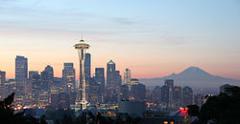
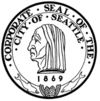
Seattle (pronounced [siËaËnR¦tÉ«Ì©] ( listen) see-AT-Éol or [siËaËnR¦É¾É«Ì©]) is a major coastal seaport and the seat of King County, in the U.S. state of Washington. With 608,660 residents as of the 2010 Census, Seattle is the largest city in the Pacific Northwest region of North America and the largest city on the West Coast north of San Francisco. The Seattle metropolitan area of about 3.4 million inhabitants is the 15th largest metropolitan area in the United States. The city is situated on a narrow isthmus between Puget Sound (an arm of the Pacific Ocean) and Lake Washington, about 114 miles (183 km) south of the Canada aeUnited States border, yet further north than Toronto. In 2010, the container ports in the Seattle metropolitan area (Seattle-Tacoma) were the third busiest in the United States, after Los Angeles aeLong Beach and New York aeNew Jersey, serving as a major gateway for trade with Asia.
listen) see-AT-Éol or [siËaËnR¦É¾É«Ì©]) is a major coastal seaport and the seat of King County, in the U.S. state of Washington. With 608,660 residents as of the 2010 Census, Seattle is the largest city in the Pacific Northwest region of North America and the largest city on the West Coast north of San Francisco. The Seattle metropolitan area of about 3.4 million inhabitants is the 15th largest metropolitan area in the United States. The city is situated on a narrow isthmus between Puget Sound (an arm of the Pacific Ocean) and Lake Washington, about 114 miles (183 km) south of the Canada aeUnited States border, yet further north than Toronto. In 2010, the container ports in the Seattle metropolitan area (Seattle-Tacoma) were the third busiest in the United States, after Los Angeles aeLong Beach and New York aeNew Jersey, serving as a major gateway for trade with Asia.
The Seattle area had been inhabited by Native Americans for at least 4,000 years before the first permanent white settlers. Arthur A. Denny and his group of travelers, subsequently known as the Denny Party, arrived at Alki Point on November 13, 1851. The settlement was moved to its current site and named "Seattle" in 1853, after Chief Si'ahl of the local Duwamish and Suquamish tribes.
Logging was Seattle's first major industry, but by the late 19th century the city had become a commercial and shipbuilding center as a gateway to Alaska during the Klondike Gold Rush. By 1910, Seattle was one of the 25 largest cities in the country. However, the Great Depression severely damaged the city's economy. Growth returned during and after World War II, due partially to the local Boeing company, which established Seattle as a center for aircraft manufacturing. The city developed as a technology center in the 1980s. The stream of new software, biotechnology, and internet companies led to an economic revival, which increased the city's population by 50,000 between 1990 and 2000. More recently, Seattle has become a hub for "green" industry and a model for sustainable development.
Seattle has a noteworthy musical history. From 1918 to 1951, there were nearly two dozen jazz nightclubs along Jackson Street in the current Chinatown/International District. The jazz scene developed the early careers of Ray Charles, Quincy Jones, Ernestine Anderson and others. Seattle is also the birthplace of rock legend Jimi Hendrix and the rock music style known as "grunge", which was made famous by local groups Melvins, Nirvana, Soundgarden, Alice in Chains, and Pearl Jam. In more recent years, Seattle has been known for indie rock and indie dance music.

Archaeological excavations suggest that humans have inhabited the Seattle area for at least 4,000 years. By the time the first European settlers arrived in the area, the people (subsequently called the Duwamish tribe) occupied at least seventeen villages in the areas around Elliott Bay.
The first European to visit the Seattle area was George Vancouver, in May 1792 during his 1791 ae95 expedition to chart the Pacific Northwest.
In 1851, a large party led by Luther Collins made a location on land at the mouth of the Duwamish River; they formally claimed it on September 14, 1851. Thirteen days later, members of the Collins Party on the way to their claim passed three scouts of the Denny Party. Members of the Denny Party claimed land on Alki Point on September 28, 1851. The rest of the Denny Party set sail from Portland, Oregon and landed on Alki point during a rainstorm on November 13, 1851.
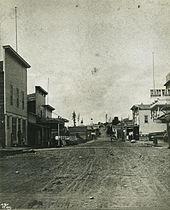
After a difficult winter, most of the Denny Party relocated across Elliott Bay and founded the village of "Dewamps" or "Duwamps" on the site of present day Pioneer Square. Charles Terry and John Low remained at the original landing location and established a village they initially called "New York", but renamed "New York Alki" in April 1853, from a Chinook word meaning, roughly, "by and by" or "someday". For the next few years, New York Alki and Duwamps competed for dominance, but in time Alki was abandoned and its residents moved across the bay to join the rest of the settlers.
David Swinson ("Doc") Maynard, one of Duwamps's founders, was the primary advocate to rename the village "Seattle" after Chief Sealth ("Seattle") of the Duwamish and Suquamish tribes. The name "Seattle" appears on official Washington Territory papers dated May 23, 1853, when the first plats for the village were filed. In 1855, nominal land settlements were established. On January 14, 1865, the Legislature of Territorial Washington incorporated the Town of Seattle with a board of trustees managing the city. The town of Seattle remained a mere precinct of King County until late 1869 when a new petition was filed and the city was re-incorporated with a Mayor-council government. The corporate seal of the City of Seattle carries the date "1869."
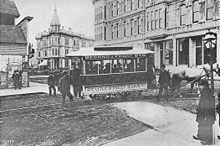
Seattle has a history of boom and bust cycles, as is common to cities near areas of extensive natural and mineral resources. Seattle has risen several times economically, then gone into precipitous decline, but it has typically used those periods to rebuild solid infrastructure.
The first such boom, covering the early years of the city, was fueled by the lumber industry. (During this period the road now known as Yesler Way was nicknamed "Skid Road", after the timber skidding down the hill to Henry Yesler's sawmill. This is considered a possible origin for the term which later entered the wider American lexicon as Skid Row.) Like much of the American West, Seattle saw numerous conflicts between labor and management, as well as ethnic tensions that culminated in the anti-Chinese riots of 1885 ae1886. This violence was caused by unemployed whites who determined to drive the Chinese from Seattle (anti-Chinese riots also occurred in Tacoma). In 1900, Asians were 4.2% of the population. Martial law was declared, and federal troops were brought in to put down the disorder. Nevertheless, the economic success in the Seattle area was so great that when the Great Seattle fire of 1889 destroyed the central business district, a far grander city center rapidly emerged in its place. Finance company Washington Mutual, for example, was founded in the immediate wake of the fire. This boom was followed by the construction of a park system, designed by the Olmsted brothers' landscape architecture firm. However, the Panic of 1893 hit Seattle hard.
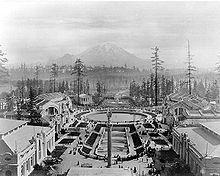
The second and most dramatic boom and bust resulted from the Klondike Gold Rush, which ended the depression that had begun with the Panic of 1893; in a short time, Seattle became a major transportation center. On July 14, 1897, the S.S. Portland docked with its famed "ton of gold", and Seattle became the main transport and supply point for the miners in Alaska and the Yukon. Few of those working men found lasting wealth, however; it was Seattle's business of clothing the miners and feeding them salmon that panned out in the long run. Along with Seattle, other cities like Everett, Tacoma, Port Townsend, Bremerton, and Olympia, all in the Puget Sound region, became competitors for exchange, rather than mother lodes for extraction, of precious metals. The boom lasted well into the early part of the 20th century and funded many new Seattle companies and products. In 1907, 19-year-old James E. Casey borrowed $100 from a friend and founded the American Messenger Company (later UPS). Other Seattle companies founded during this period include Nordstrom and Eddie Bauer. The Gold Rush era culminated in the Alaska-Yukon-Pacific Exposition of 1909, which is largely responsible for the layout of today's University of Washington campus.
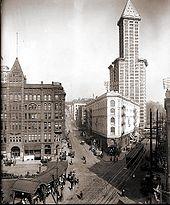
A shipbuilding boom in the early part of the 20th century became massive during World War I, making Seattle somewhat of a company town; the subsequent retrenchment led to the Seattle General Strike of 1919, the first general strike in the country. A 1912 city development plan by Virgil Bogue went largely unused. Seattle was mildly prosperous in the 1920s but was particularly hard hit in the Great Depression, experiencing some of the country's harshest labor strife in that era. Violence during the Maritime Strike of 1934 cost Seattle much of its maritime traffic, which was rerouted to the Port of Los Angeles.
Seattle was also the home base of impresario Alexander Pantages who, starting in 1902, opened a number of theaters in the city exhibiting vaudeville acts and silent movies. His activities soon expanded, and the thrifty Greek went on and became one of America's greatest theater and movie tycoons. Between Pantages and his rival John Considine, Seattle was for a while the western United States' vaudeville mecca. B. Marcus Priteca, the Scottish-born and Seattle-based architect, built several theaters for Pantages, including some in Seattle. The theaters he built for Pantages in Seattle have been either demolished or converted to other uses, but many other theaters survive in other cities of the U.S., often retaining the Pantages name; Seattle's surviving Paramount Theatre, on which he collaborated, was not a Pantages theater.
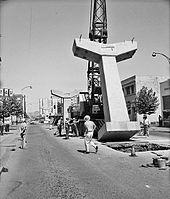
War work again brought local prosperity during World War II, this time centered on Boeing aircraft. The war dispersed the city's numerous Japanese-American businessmen due to the Japanese American internment. After war, the local economy dipped. It rose again with Boeing's growing dominance in the commercial airliner market. Seattle celebrated its restored prosperity and made a bid for world recognition with the Century 21 Exposition, the 1962 World's Fair. Another major local economic downturn was in the late 1960s and early 1970s. Many people left the area to look for work elsewhere, and two local real estate agents put up a billboard reading "Will the last person leaving Seattle ae Turn out the lights."
Seattle remained the corporate headquarters of Boeing until 2001, when the company separated its headquarters from its major production facilities; the headquarters were moved to Chicago. The Seattle area is still home to Boeing's Renton narrow-body plant (where the 707, 720, 727, and 757 were assembled, and the 737 is assembled today) and Everett wide-body plant (assembly plant for the 747, 767, 777, and 787). The company's credit union for employees, BECU, remains based in the Seattle area, though it is now open to all residents of Washington.
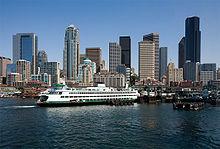
As prosperity began to return in the 1980s, the city was stunned by the Wah Mee massacre in 1983, when 13 people were killed in an illegal gambling club in the International District, Seattle's Chinatown. Beginning with Microsoft's 1979 move from Albuquerque, New Mexico to nearby Bellevue, Washington, Seattle and its suburbs became home to a number of technology companies including Amazon.com, RealNetworks, McCaw Cellular (now part of AT&T Mobility), VoiceStream (now T-Mobile USA), and biomedical corporations such as HeartStream (later purchased by Philips), Heart Technologies (later purchased by Boston Scientific), Physio-Control (later purchased by Medtronic), ZymoGenetics, ICOS (later purchased by Eli Lilly and Company) and Immunex (later purchased by Amgen). This success brought an influx of new citizens with a population increase within city limits of almost 50,000 between 1990 and 2000, and saw Seattle's real estate become some of the most expensive in the country. Many of the Seattle area's tech companies remain relatively strong, but the frenzied dot-com boom years ended in early 2001.
Seattle in this period attracted widespread attention as home to these many companies, but also by hosting the 1990 Goodwill Games and the APEC leaders conference in 1993, as well as through the worldwide popularity of grunge, a sound that had developed in Seattle's independent music scene. Another bid for worldwide attention aehosting the World Trade Organization Ministerial Conference of 1999 aegarnered visibility, but not in the way its sponsors desired, as related protest activity and police reactions to those protests overshadowed the conference itself. The city was further shaken by the Mardi Gras Riots in 2001, and was literally shaken the following day by the Nisqually Earthquake.
The UK consulting firm Mercer, in a 2011 assessment "conducted to help governments and major companies place employees on international assignments", ranked Seattle 48th worldwide in quality of living; the survey factored in political stability, personal freedom, sanitation, crime, housing, the natural environment, recreation, banking facilities, availability of consumer goods, education, and public services including transportation.

With a total area of 83.9 square miles, Seattle lies in the geographical co-ordinates of 47.37 North latitude and 122.20 West longitude. It is the northernmost city with at least 500,000 people in the United States. The topography of Seattle is hilly. Seattle lies on seven hills including Capitol Hill, First Hill, West Seattle, Beacon Hill, Magnolia, Denny Hill and Queen Anne. The Kitsap and the Olympic peninsulas along with the Olympic mountains lie to the west of Puget Sound, while the Cascade Range and Lake Sammamish lie to the east of Lake Washington. The lush green forests and the numerous water bodies have provided livelihood for many hunting and gathering communities.
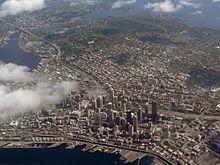
Seattle is located between the saltwater Puget Sound (an arm of the Pacific Ocean) to the west and Lake Washington to the east. The city's chief harbor, Elliott Bay, is part of Puget Sound, making the city an oceanic port. To the west, beyond Puget Sound, are the Kitsap Peninsula and Olympic Mountains on the Olympic Peninsula; to the east, beyond Lake Washington and the eastside suburbs, are Lake Sammamish and the Cascade Range. Lake Washington's waters flow to Puget Sound through the Lake Washington Ship Canal (consisting of two man-made canals, Lake Union, and the Hiram M. Chittenden Locks at Salmon Bay, ending in Shilshole Bay on Puget Sound).
The sea, rivers, forests, lakes, and fields surrounding Seattle were once rich enough to support one of the world's few sedentary hunter-gatherer societies. The surrounding area lends itself well to sailing, skiing, bicycling, camping, and hiking year-round.
The city itself is hilly, though not uniformly so. Like Rome, the city is said to lie on seven hills; the lists vary, but typically include Capitol Hill, First Hill, West Seattle, Beacon Hill, Queen Anne, Magnolia, and the former Denny Hill. The Wallingford, Mount Baker, and Crown Hill neighborhoods are technically located on hills as well. Many of the hilliest areas are near the city center, with Capitol Hill, First Hill, and Beacon Hill collectively constituting something of a ridge along an isthmus between Elliott Bay and Lake Washington. The break in the ridge between First Hill and Beacon Hill is man-made, the result of two of the many regrading projects that reshaped the topography of the city center. The topography of the city center was also changed by the construction of a seawall and the artificial Harbor Island (completed 1909) at the mouth of the city's industrial Duwamish Waterway, the terminus of the Green River. The highest point within city limits is at High Point in West Seattle, roughly located near 35th Ave SW and SW Myrtle St. Other notable hills include Crown Hill, View Ridge/Wedgwood/Bryant, Maple Leaf, Phinney Ridge, Mt. Baker Ridge, and Highlands/Carkeek/Bitterlake.
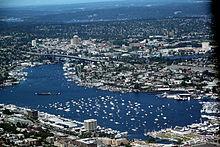
North of the city center, Lake Washington Ship Canal connects Puget Sound to Lake Washington. It incorporates four natural bodies of water: Lake Union, Salmon Bay, Portage Bay, and Union Bay.
Due to its location in the Pacific Ring of Fire, Seattle is in a major earthquake zone. On February 28, 2001, the magnitude 6.8 Nisqually earthquake did significant architectural damage, especially in the Pioneer Square area (built on reclaimed land, as are the Industrial District and part of the city center), but caused no fatalities. Other strong quakes occurred on January 26, 1700 (estimated at 9 magnitude), December 14, 1872 (7.3 or 7.4), April 13, 1949 (7.1), and April 29, 1965 (6.5). The 1949 quake caused eight known deaths, all in Seattle; the 1965 quake caused three deaths in Seattle directly, and one more by heart failure. Although the Seattle Fault passes just south of the city center, neither it nor the Cascadia subduction zone has caused an earthquake since the city's founding. The Cascadia subduction zone poses the threat of an earthquake of magnitude 9.0 or greater, capable of seriously damaging the city and collapsing many buildings, especially in zones built on fill.
According to the United States Census Bureau, the city has a total area of 142.5 square miles (369 km2), 83.9 square miles (217 km2) of which is land and 58.7 square miles (152 km2) water (41.16% of the total area).
Seattle's climate is usually described as oceanic or temperate marine, with mild, wet winters and warm, dry summers. Like much of the Pacific Northwest, according to the Koppen climate classification it falls within a cool/mild wet winter, and dry-summer subtropical zone (Csb), with "cool"-summer Mediterranean characteristics. Other climate classification systems, such as Trewartha, place it firmly in the Oceanic zone (Do), like much of Western Europe.
Temperature extremes are moderated by the adjacent Puget Sound, greater Pacific Ocean, and Lake Washington. The region is largely denied Pacific storms by the Olympic Mountains and Arctic air by the Cascade Range. Despite being on the margin of the rain shadow of the Olympic Mountains, the city has a reputation for frequent rain. This reputation stems from the frequency of precipitation in the fall, winter, and spring. In an average year, more than 0.3 mm (0.01 in) of precipitation falls on 150 days. It is cloudy 201 days out of the year and partly cloudy 93 days. The location of official weather and climatic records, the Seattle-Tacoma International Airport, is located about 19 km (12 miles) south of downtown in the city of SeaTac, and records more cloudy days and fewer partly cloudy days per year. For this reason, official weather and climatic records do not actually reflect the weather and climate conditions of the city proper.
At 944 mm (37.49 in.), in reality, the city receives less precipitation annually than New York City (1201 mm/47.28 in.), Atlanta (1290 mm/50.79 in.), Boston (1055 mm/41.53 in.), Baltimore (1038 mm/40.87 in.), Portland, Maine (1128 mm/44.41 in.), Jacksonville, Florida (1304 mm/51.34 in.), and most cities on the Eastern Seaboard of the U.S. These stats may be slightly misleading, however, as Seattle proper gets less rain than the region as a whole. Bremerton (15 miles SW of Seattle), and Issaquah (15 miles SE of Seattle) both receive 65 inches of rainfall annually, which means that some cities in the Seattle metro area would be considered the rainiest cities in the continental U.S.
Surprisingly, Seattle proper was not listed in a study that revealed the 10 rainiest cities in the continental United States. This is due largely to Seattle's dry summers, which result in statistically moderate annual accumulations, and its position on the eastern banks of the Puget Sound, which result in Seattle receiving less precipitation than other cities in the metro area. However, the city is becoming wetter; the current annual rainfall average of 952 millimeters reflects an increase of 11 mm. Seattle receives the largest amount of rainfall of any U.S. city of more than 250,000 people in November, and is in the top 10 through winter, but is in the lower half of all cities from June to September. Seattle is in the top 5 rainiest U.S. cities by number of precipitations days, and it gets the least amount of annual sunlight of all major cities in the lower-48 states. Thunderstorms are rare; the city reports thunder on just seven days per year. By comparison, Fort Myers, Florida reports thunder on 93 days per year, Kansas City on 52, and New York City on 25.
While heavy downpours are not as common in Seattle as they are in other areas of the U.S., there are exceptions. One downpour occurred on December 2 ae4, 2007, when sustained hurricane-force winds and widespread heavy rainfall associated with a strong "Pineapple Express" event occurred in the greater Puget Sound area and the western parts of Washington and Oregon. Interstate 5 at Chehalis, Washington was covered by a mudslide and closed for almost two days; the result of heavy clear-cut logging in the highlands above the freeway. Precipitation totals exceeded 356 mm (14 inches) in some areas with winds topping out at 209 km/hr (130 mph) along coastal Oregon. It became the second wettest event in Seattle history when a little over 130 millimetres (5.1 in) of rain fell on Seattle in a 24 hour period. The rain indirectly led to five deaths and widespread flooding and damage.
Autumn, winter, and spring are frequently characterized by rain. Winters are cool and wet with average lows in the mid 30s °F (2 ae4 °C) at night. Colder weather does sometimes occur. Summers are fairly dry and warm by comparison, with average daytime highs around 73 °F (23 °C). Hotter weather occurs during some summer days. Seattle's hottest official recorded temperature was 103 °F (39 °C) on July 29, 2009; the coldest recorded temperature was 0 °F ( na18 °C) on January 31, 1950. Eastern suburbs of Seattle, such as Bellevue and Issaquah, are typically even hotter when the temperature soars above 80 °F (27 °C), due to their location closer to downslope winds from the Cascade Mountains and further from Puget Sound; on Seattle's recorded hottest day of July 29, 2009, parts of south Bellevue, Renton, and Issaquah peaked at 110 °F (43 °C).
Eighty miles (130 km) to the west, the Hoh Rain Forest in Olympic National Park on the western flank of the Olympic Mountains receives an annual average rainfall of 142 inches (361 cm). Sixty miles to the south of Seattle, the state capital Olympia, which is out of the rain shadow, receives an annual average rainfall of 52 inches (132 cm).
Seattle typically receives some snowfall on an annual basis but heavy snow is rare. Average annual snowfall, as measured at Sea-Tac Airport, is 8.1 inches (21 cm). Single calendar-day snowfall of six inches or greater has occurred on only 15 days since 1948, and only once since February 17, 1990, when 6.8 inches of snow officially fell at Sea-Tac airport on January 18, 2012. This moderate snow event was officially the 12th snowiest calendar day at the airport since 1948 and snowiest since November 1985. Much of the city of Seattle proper received somewhat lesser snowfall accumulations. Locations to the south of Seattle received more, with Olympia and Chehalis receiving 14 inches (36 cm) to 18 inches (46 cm) even before noon. Another moderate snow event occurred from December 12 ae25, 2008, when over one foot of snow fell and stuck on much of the roads, causing widespread difficulties in a city not equipped for clearing snow. Seattle's daily record snowfall is 20 inches (51 cm) on January 13, 1950. The largest snowstorm on record occurred from January 5 ae9, 1880, with snow drifting to 6 feet (1.8 m) in places at the end of the snow event. From January 31 to February 2, 1916, another heavy snow event occurred with 29 inches (74 cm) of snow on the ground by the time the event was over.
A very sunny and dry climate typically dominates from May to late September. An average of 0.8 inches (20 mm) of rain falls in July and 1.0 inch (25 mm) in August. Summer thunderstorms are rare.
The Puget Sound Convergence Zone is an important feature of Seattle's weather. In the convergence zone, air arriving from the north meets air flowing in from the south. Both streams of air originate over the Pacific Ocean; airflow is split by the Olympic Mountains to Seattle's west, then reunited to the east. When the air currents meet, they are forced upward, resulting in convection. Thunderstorms caused by this activity can occur north and south of town, but Seattle itself rarely receives more weather than occasional thunder and small hail showers. The Hanukkah Eve Wind Storm in December 2006 is an exception that brought heavy rain and winds gusting up to 69 mph (111 km/h), not caused by the Puget Sound Convergence Zone.
One of many exceptions to Seattle's reputation as a damp location occurs in El NiR±o years, when marine weather systems track as far south as California and little precipitation falls in the Puget Sound area. Since the region's water comes from mountain snow packs during the dry summer months, El NiR±o winters can not only produce substandard skiing but can result in water rationing and a shortage of hydroelectric power the following summer.
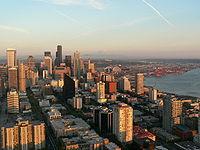
Downtown Seattle averages 71 clear (sunny) days a year, with most of those days occurring between May and September
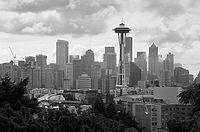
Between October and May, Seattle is mostly or partly cloudy six out of every seven days
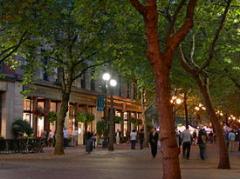
Seattle has grown through a series of annexations of smaller neighboring communities. On May 3, 1891, Magnolia, Wallingford, Green Lake, and the University District (then known as Brooklyn) were annexed. The town of South Seattle was annexed on October 20, 1905. Between January 7 and September 12, 1907, Seattle nearly doubled its land area by annexing six incorporated towns and areas of unincorporated King County, including Southeast Seattle, Ravenna, South Park, Columbia City, Ballard, and West Seattle. Three years later, after having difficulties paying a $10,000 bill from the county, the city of Georgetown merged with Seattle. Finally, on January 4, 1954, the area between N. 85th Street and N. 145th Street was annexed, including the neighborhoods of Pinehurst, Greenwood, Blue Ridge, Crown Hill, Broadview, Bitter Lake, Haller Lake, Maple Leaf, Lake City, View Ridge and Northgate.
Former Seattle mayor Greg Nickels is among those who have called Seattle "a city of neighborhoods", although the boundaries (and even names) of those neighborhoods are often open to dispute. For example, a Department of Neighborhoods spokeswoman reported that her own neighborhood has gone from "the 'CD' (Central District) to 'Madrona' to 'Greater Madison Valley' and now 'Madrona Park'.
Over a dozen Seattle neighborhoods have Neighborhood Service Centers, originally known in 1972 as "Little City Halls" and even more have their own street fair and/or parade during the summer months. The largest of the city's street fairs feature hundreds of craft and food booths and multiple stages with live entertainment, and draw more than 100,000 people over the course of a weekend. In addition, at least half a dozen neighborhoods have weekly farmers' markets, some with as many as fifty vendors.
Additionally, Puget Sound Regional Council designates several areas of Seattle as urban centers, defined as "designated planning districts intended to provide a mix of housing, employment and commercial and cultural amenities in a compact form that supports transit, walking and cycling." These urban centers may have the same name as a neighborhood but slightly different borders; for example, the Capitol Hill Urban Center is much smaller than the entire neighborhood.


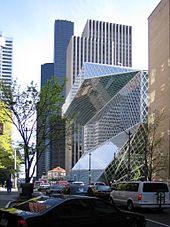
The Space Needle, dating from the 1962 Century 21 Exposition, is Seattle's most recognizable landmark. It has been featured in the logo of the former Seattle SuperSonics NBA team, the Seattle Sounders MLS team, the television show Frasier and the backgrounds of the television series Dark Angel, Grey's Anatomy, The Killing and iCarly, and films such as It Happened at the World's Fair, Sleepless in Seattle, The Twilight Saga: Eclipse, Love Happens and The Parallax View. The Space Needle has also appeared in films such as The Simpsons Movie, Say Anything, 10 Things I Hate About You and Bloodsport. The fairgrounds surrounding the Needle have been converted into Seattle Center, which remains the site of many local civic and cultural events, such as Bumbershoot, Folklife, and the Bite of Seattle. Seattle Center plays multiple roles in the city, ranging from a public fair ground to a civic center, though recent economic losses have called its viability and future into question.[100] The Seattle Center Monorail was also constructed for Century 21 and still runs from Seattle Center to Westlake Center, a downtown shopping mall, a little over a mile to the southeast.
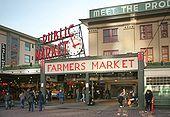
The Smith Tower was the tallest building on the West Coast from its completion in 1914 until the Space Needle overtook it in 1962.[101] The late 1980s saw the construction of Seattle's two tallest skyscrapers: the 76 story Columbia Center (completed 1985) is the tallest building in the Pacific Northwest[102] and the fourth tallest building west of the Mississippi River;[103] the Washington Mutual Tower (completed 1988) is Seattle's second tallest building.[104][105] Other notable Seattle landmarks include Pike Place Market, the Fremont Troll, the Experience Music Project and Science Fiction Museum and Hall of Fame (at Seattle Center), the Seattle Central Library, and The Seattle Great Wheel.
Starbucks has been at Pike Place Market since the coffee company was founded there in 1971. The first store is still operating a block south of its original location.[106]
The National Register of Historic Places has over 150 Seattle listings.[107] The city also designates its own landmarks.[108]
From 1869 until 1982, Seattle was known as the "Queen City".[109] Seattle's current official nickname is the "Emerald City", the result of a contest held in 1981;[110][111] the reference is to the lush evergreen forests of the area. Seattle is also referred to informally as the "Gateway to Alaska", "Rain City", and "Jet City",[111] the last from the local influence of Boeing. The Seattle area has also been called "The 206" in reference to the telephone area code. Seattle residents are known as Seattleites.
Seattle has been a regional center for the performing arts for many years. The century-old Seattle Symphony Orchestra is among the world's most recorded[112] and performs primarily at Benaroya Hall.[113] The Seattle Opera and Pacific Northwest Ballet, which perform at McCaw Hall (opened 2003 on the site of the former Seattle Opera House at Seattle Center), are comparably distinguished,[114][115] with the Opera being particularly known for its performances of the works of Richard Wagner[116][117] and the PNB School (founded in 1974) ranking as one of the top three ballet training institutions in the United States.[114] The Seattle Youth Symphony Orchestras (SYSO) is the largest symphonic youth organization in the United States.[118] The city also boasts lauded summer and winter chamber music festivals organized by the Seattle Chamber Music Society.[119]
The 5th Avenue Theatre, built in 1926, stages Broadway-style musical shows[120] featuring both local talent and international stars.[121] Seattle has "around 100" theatrical production companies[122] and over two dozen live theatre venues, many of them associated with fringe theatre;[123][124] Seattle is probably second only to New York for number of equity theaters[125] (28 Seattle theater companies have some sort of Actors' Equity contract).[122] In addition, the 900-seat Romanesque Revival Town Hall on First Hill hosts numerous cultural events, especially lectures and recitals.[126]
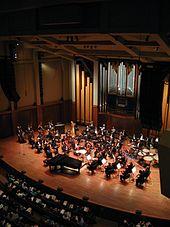
Seattle is considered the home of grunge music because it was home to artists such as Nirvana, Soundgarden, Alice in Chains, Pearl Jam, and Mudhoney, all of whom reached vast audiences in the early 1990s.[127] The city is also home to such varied musicians as avant-garde jazz musicians Bill Frisell and Wayne Horvitz, hot jazz musician Glenn Crytzer, rapper Sir Mix-a-Lot, smooth jazz saxophonist Kenny G, Heart, heavy metal bands QueensrR¿che, Demon Hunter, Metal Church, Nevermore, Himsa, and Sunn O))), as well as such poppier rock bands as Harvey Danger, Goodness, and The Presidents of the United States of America. Such musicians as Jimi Hendrix, Duff McKagan, Nikki Sixx, and Quincy Jones spent their formative years in Seattle.
Since the grunge era, the area has hosted a diverse and influential alternative music scene. The Seattle record label Sub Pop aethe first to sign Nirvana and Soundgarden aehas signed such non-grunge bands as Band of Horses, Modest Mouse, Murder City Devils, Sunny Day Real Estate, Death Cab for Cutie, The Postal Service, Iron and Wine, Flight of the Conchords, and Fleet Foxes. Seattle has also put out a number of hiphop artists, such as Blue Scholars, Macklemore, Fresh Espresso, and group Shabazz Palaces.[127]
Earlier Seattle-based popular music acts include the collegiate folk group The Brothers Four; The Wailers, a 1960s garage band; The Ventures, an instrumental rock band; pop Young Fresh Fellows and The Posies; pop-punk The Fastbacks; the well-traveled avant-rock of Sun City Girls; and the outright punk of The Fartz (later 10 Minute Warning), The Gits.[128]
Over the years, a number of songs have been written about Seattle.
Seattle annually sends a team of spoken word slammers to the National Poetry Slam and considers itself home to such performance poets as Buddy Wakefield, two-time Individual World Poetry Slam Champ;[129] Anis Mojgani, two-time National Poetry Slam Champ;[130] and Danny Sherrard, 2007 National Poetry Slam Champ and 2008 Individual World Poetry Slam Champ.[131] Seattle also hosted the 2001 national Poetry Slam Tournament. The Seattle Poetry Festival is a biennial poetry festival that (launched first as the Poetry Circus in 1997) has featured local, regional, national, and international names in poetry.[132]
The city also has movie houses showing both Hollywood productions and works by independent filmmakers.[133] Among these, the Seattle Cinerama stands out as one of only three movie theaters in the world still capable of showing three-panel Cinerama films.[134]
As of 2010, Seattle has one major daily newspaper, The Seattle Times. The Seattle Post-Intelligencer, known as the P-I, published a daily newspaper from 1863 to March 17, 2009 before switching to a strictly on-line publication. There is also the Seattle Daily Journal of Commerce,[135] and the University of Washington publishes The Daily, a student-run publication, when school is in session. The most prominent weeklies are the Seattle Weekly and The Stranger; both consider themselves "alternative" papers.[136] Real Change is a weekly street newspaper that is sold mainly by homeless persons as an alternative to panhandling. There are also several ethnic newspapers, including the Northwest Asian Weekly, and numerous neighborhood newspapers, including the North Seattle Journal.
Seattle is also well served by television and radio, with all major U.S. networks represented, along with at least five other English-language stations and two Spanish-language stations.[137] Seattle cable viewers also receive CBUT 2 (CBC) from Vancouver, British Columbia.
Non-commercial radio stations include NPR affiliates KUOW-FM 94.9 and KPLU-FM 88.5 (Tacoma). Other stations include KEXP-FM 90.3 (affiliated with EMP), community radio KBCS-FM 91.3 (affiliated with Bellevue College), and high school radio KNHC-FM 89.5, which broadcasts an electronic dance music radio format and is owned by the public school system and operated by students of Nathan Hale High School. Many Seattle radio stations are also available through Internet radio, with KEXP in particular being a pioneer of Internet radio.[138] Seattle also has numerous commercial radio stations. In a March 2012 report by the consumer research firm Arbitron, the top FM stations were KRWM (adult contemporary format), KIRO-FM (news/talk), and KISW (active rock) while the top AM stations were KOMO (AM) (all news), KJR (AM) (all sports), KIRO (AM) (all sports).[139]
Seattle-based online magazines Worldchanging and Grist.org were two of the "Top Green Websites" in 2007 according to TIME.[140]
Seattle also has many online news media websites. The two largest are The Seattle Times and Seattle Post-Intelligencer.
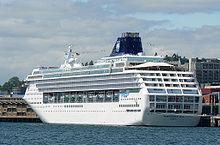
Among Seattle's prominent annual fairs and festivals are the 24-day Seattle International Film Festival,[142] Northwest Folklife over the Memorial Day weekend, numerous Seafair events throughout July and August (ranging from a Bon Odori celebration to the Seafair Cup hydroplane races), the Bite of Seattle, one of the largest Gay Pride festivals in the United States, and the art and music festival Bumbershoot, which programs music as well as other art and entertainment over the Labor Day weekend. All are typically attended by 100,000 people annually, as are the Seattle Hempfest and two separate Independence Day celebrations.[143][144][145][146]
Other significant events include numerous Native American pow-wows, a Greek Festival hosted by St. Demetrios Greek Orthodox Church in Montlake, and numerous ethnic festivals (many associated with FestR¡l at Seattle Center).[147]
There are other annual events, ranging from the Seattle Antiquarian Book Fair & Book Arts Show;[148] an anime convention, Sakura-Con;[149] Penny Arcade Expo, a gaming convention;[150] a two-day, 9,000-rider Seattle to Portland Bicycle Classic,[151] and specialized film festivals, such as the Maelstrom International Fantastic Film Festival, the Northwest Asian-American Film Festival, Children's Film Festival Seattle, Translation: the Seattle Transgender Film Festival, the Seattle Gay and Lesbian Film Festival, and the Seattle Polish Film Festival.[152][153]
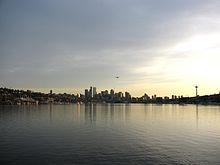
The Henry Art Gallery opened in 1927, the first public art museum in Washington.[154] The Seattle Art Museum (SAM) opened in 1933; SAM opened a museum downtown in 1991 (expanded and reopened 2007); since 1991, the 1933 building has been SAM's Seattle Asian Art Museum (SAAM).[155] SAM also operates the Olympic Sculpture Park (opened 2007) on the waterfront north of the downtown piers. The Frye Art Museum is a free museum on First Hill. Regional history collections are at the Loghouse Museum in Alki, Klondike Gold Rush National Historical Park, the Museum of History and Industry and the Burke Museum of Natural History and Culture. Industry collections are at the Center for Wooden Boats and the adjacent Northwest Seaport, the Seattle Metropolitan Police Museum, and the Museum of Flight. Regional ethnic collections include the Nordic Heritage Museum, the Wing Luke Asian Museum and the Northwest African American Museum. Seattle has artist-run galleries,[156] including 10-year veteran Soil Art Gallery,[157] and the newer Crawl Space Gallery.[158]
Woodland Park Zoo opened as a private menagerie in 1889, but was sold to the city in 1899.[159] The Seattle Aquarium has been open on the downtown waterfront since 1977 (undergoing a renovation 2006).[160] The Seattle Underground Tour is an exhibit of places that existed before the Great Fire.[161] The Seattle Great Wheel, one of the largest Ferris wheels in the U.S., opened in June 2012 as a new, permanent attraction on the city's waterfront, at Pier 57, next to Downtown Seattle.[162] The city also has many community centers for recreation, including Rainier Beach, Van Asselt, Rainier, and Jefferson south of the Ship Canal and Green Lake, Laurelhurst, Loyal Heights north of the Canal, and Meadowbrook.[163]
Since the middle 1990s, Seattle has experienced significant growth in the cruise industry, especially as a departure point for Alaska cruises. In 2008, a record total of 886,039 cruise passengers passed through the city, surpassing the number for Vancouver, BC, the other major departure point for Alaska cruises.[164]
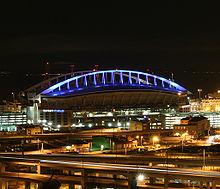
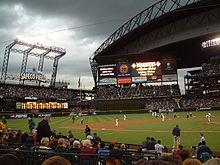
Seattle's professional sports history began at the start of the 20th century with the PCHA's Seattle Metropolitans, which in 1917 became the first American hockey team to win the Stanley Cup.[165] Today Seattle has three major professional sports teams: The National Football League's Seattle Seahawks, Major League Baseball's Seattle Mariners, and Major League Soccer's Seattle Sounders FC. Other sports teams include the 2004 and 2010 Women's National Basketball Association champions, Seattle Storm.[166] From 1967 to 2008 Seattle was also home to an NBA franchise, the Seattle SuperSonics, who were the 1978 ae79 NBA champions. The team relocated to Oklahoma City after the 2007 ae08 season and became the Oklahoma City Thunder.[167] Seattle was also home to a previous Major League Baseball franchise in 1969, the Seattle Pilots. The team relocated to Milwaukee and became the Milwaukee Brewers in 1970. The Seattle Thunderbirds are a major-junior hockey team that plays in one of the Canadian major-junior hockey leagues, the WHL (Western Hockey League). The Thunderbirds moved to nearby Kent, Washington during the 2008 ae2009 season.[168] The Seattle Sounders FC began play in Major League Soccer in 2009.[169]
The Major League Baseball All-Star game was held in Seattle twice, first at the Kingdome in 1979 and again at Safeco Field in 2001.[170] That same year, the Seattle Mariners tied the all-time single regular season wins record with 116 wins.[171] The NBA All-Star game was also held in Seattle twice, the first in 1974 at the Seattle Center Coliseum and the second in 1987 at the Kingdome.[172]
In 2006, CenturyLink Field hosted the 2005 ae06 NFL playoffs. In 2008, CenturyLink Field hosted the first game of the 2007 ae08 NFL playoffs, in which the Seahawks defeated the Washington Redskins, 35 ae14. CenturyLink Field also serves as the home field for the Seattle Sounders FC of Major League Soccer. Seattle also boasts a strong history in collegiate sports. The University of Washington and Seattle University are NCAA Division I schools.
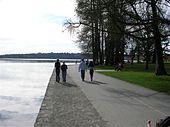
Seattle's mild, temperate marine climate allows year-round outdoor recreation, including walking, cycling, hiking, skiing, snowboarding, kayaking, rock climbing, motor boating, sailing, team sports, and swimming.[173] In town, many people walk around Green Lake, through the forests and along the bluffs and beaches of 535-acre (2.2 km2) Discovery Park (the largest park in the city) in Magnolia, along the shores of Myrtle Edwards Park on the Downtown waterfront, along the shoreline of Lake Washington at Seward Park, along Alki Beach in West Seattle, or along the Burke-Gilman Trail. Also popular are hikes and skiing in the nearby Cascade or Olympic Mountains and kayaking and sailing in the waters of Puget Sound, the Strait of Juan de Fuca, and the Strait of Georgia. In 2005, Men's Fitness magazine named Seattle the fittest city in the United States.[174]
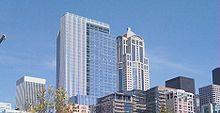
Seattle's economy is driven by a mix of older industrial companies, and "new economy" Internet and technology companies, service, design and clean technology companies. The city's gross metropolitan product was $231 billion in 2010, making it the 12th largest metropolitan economy in the United States.[175][176] The Port of Seattle, which also operates Seattle aeTacoma International Airport, is a major gateway for trade with Asia and cruises to Alaska, and is the 8th largest port in the United States in terms of container capacity.[177] Though it has been affected by the recent recession, Seattle has retained a comparatively strong economy, and remains a hotbed for start-up businesses, especially in green building and clean technologies: it was ranked as America's No. 1 "smarter city" based on its government policies and green economy.[178] February 2010, the city government committed Seattle to becoming North America's first "climate neutral" city, with a goal of reaching zero net per capita greenhouse gas emissions by 2030.[179]
Still, very large companies dominate the business landscape. Four companies on the 2008 Fortune 500 list of the United States' largest companies, based on total revenue are headquartered in Seattle: Internet retailer Amazon.com (#100), coffee chain Starbucks (#241), department store Nordstrom (#270), and freight forwarder Expeditors International of Washington (#458).[180] Other Fortune 500 companies popularly associated with Seattle are based in nearby Puget Sound cities. Warehouse club chain Costco (#29), the largest retail company in Washington, is based in Issaquah. Providence Health & Services, the largest health care system and the fifth largest employer, is based in Renton, Washington. Microsoft (#44) and Nintendo of America are located in Redmond. Weyerhaeuser, the forest products company (#147), is based in Federal Way. Finally, Bellevue is home to truck manufacturer PACCAR (#169), and to international mobile telephony giant T-Mobile's U.S. subsidiary, T-Mobile USA.[180] The city has a reputation for heavy coffee consumption;[181] coffee companies founded or based in Seattle include Starbucks,[182] Seattle's Best Coffee,[183][184] and Tully's.[185] There are also many successful independent artisanal espresso roasters and cafes.[181]
Prior to moving its headquarters to Chicago, aerospace manufacturer Boeing (#27) was the largest company based in Seattle. Its largest division is still headquartered in nearby Renton, and the company has large aircraft manufacturing plants in Everett and Renton, so it remains the largest private employer in the Seattle metropolitan area.[186] Former Seattle Mayor Greg Nickels announced a desire to spark a new economic boom driven by the biotechnology industry in 2006. Major redevelopment of the South Lake Union neighborhood is underway, in an effort to attract new and established biotech companies to the city, joining biotech companies Corixa (acquired by GlaxoSmithKline), Immunex (now part of Amgen), Trubion, and ZymoGenetics. Vulcan Inc., the holding company of billionaire Paul Allen, is behind most of the development projects in the region. While some see the new development as an economic boon, others have criticized Nickels and the Seattle City Council for pandering to Allen's interests at taxpayers' expense.[187] Also in 2006, Expansion Magazine ranked Seattle among the top 10 metropolitan areas in the nation for climates favorable to business expansion.[188] In 2005, Forbes ranked Seattle as the most expensive American city for buying a house based on the local income levels.[189]
Alaska Airlines, operating a hub at Seattle aeTacoma International Airport, maintains its headquarters in the city of SeaTac, next to the airport.[190]
According to the 2010 census, Seattle had a population of 608,660 and the racial and ethnic composition was as follows:[194]
Seattle's population has historically been predominantly white. The 2010 census showed that Seattle was one of the whitest big cities in the country, but the percentage of whites has been gradually declining.[195] In 1960, whites comprised 91.6% of the city's population, but by 2010 the percentage of whites had shrunk to 69.5%,[194] as compared with a national average of 73.4%.[196] According to the 2006 ae2008 American Community Survey, approximately 78.9% of residents over the age of five spoke only English at home. While Spanish was spoken by 4.5% of the population, people who spoke other Indo-European languages made up 3.9% of the population, and people who spoke Asian languages other than Indo-European languages at home made up 10.2% of the population. People who spoke other languages made up 2.5% of the population.[197]
Seattle has seen steady growth in racial and ethnic diversity, with the immigrant population growing 40% between the 1990 and 2000 censuses.[198] According to a 2010 United States Census Bureau report, Seattle's 98118 zip code (in the Columbia City neighbourhood) was the most multicultural zip code in the United States.[199] The Chinese population in the Seattle area has origins in mainland China, Hong Kong, Southeast Asia, and Taiwan. The earliest Chinese-Americans that came in the late 19th and early 20th centuries were almost entirely from Guangdong province. The Seattle area is also home to a high Vietnamese population,[200] at over 55,000 residents, and over 30,000 Somali immigrants.[201] The Seattle-Tacoma area is also home to one of the largest Cambodian communities in the United States, enumerating about 19,000 Cambodian Americans,[202] as well as one of the largest Samoan communities in the mainland U.S., with over 15,000 people having Samoan ancestry.[194][203] The Seattle area also had the highest percentage of self-identified mixed-race people of any large metropolitan area in the United States, according to the 2000 United States Census Bureau.[204]
As of 1999, the median income of a city household was $45,736, and the median income for a family was $62,195. Males had a median income of $40,929 versus $35,134 for females. The per capita income for the city was $30,306.[205] 11.8% of the population and 6.9% of families are below the poverty line. Of people living in poverty, 13.8% are under the age of 18 and 10.2% are 65 or older.[205]
It is estimated that King County has 8,000 homeless people on any given night, and many of those live in Seattle.[206] In September 2005, King County adopted a "Ten-Year Plan to End Homelessness", one of the near-term results of which is a shift of funding from homeless shelter beds to permanent housing.[207]
In recent years, the city has seen steady population growth, and has been faced with the issue of accommodating more residents. In 2006, after growing by 4,000 citizens per year for the previous 16 years, regional planners expected the population of Seattle to grow by 200,000 people by 2040.[208] However, former mayor Greg Nickels supported plans that would increase the population by 60%, or 350,000 people, by 2040 and worked on ways to accommodate this growth while keeping Seattle's single-family housing zoning laws.[208] The Seattle City Council later voted to relax height limits on buildings in the greater part of Downtown, partly with the aim to increase residential density in the city centre.[209] As a sign of increasing inner-city growth, the downtown population crested to over 60,000 in 2009, up 77% since 1990.[210]
Seattle also has a robust gay population. A 2006 study by UCLA indicated that the city has one of the highest LGBT populations per capita. With 12.9% of citizens polled identifying as gay, lesbian, bisexual, or transgender, the city ranks second of all major U.S. cities, behind San Francisco and slightly ahead of Atlanta and Minneapolis.[211] Greater Seattle also ranks second among major U.S. metropolitan areas, with 6.5% of the population being LGBT.[212]
In addition, Seattle has a relatively high number of people living alone. According to the 2000 U.S. Census interim measurements of 2004, Seattle has the fifth highest proportion of single-person households nationwide among cities of 100,000 or more residents, at 40.8%.[213]
Seattle is a charter city, with a Mayor aeCouncil form of government. Since 1911, Seattle's nine city councillors have been elected at large, rather than by geographic subdivisions.[214] The only other elected offices are the city attorney and Municipal Court judges. All city, county, and state offices are technically non-partisan.[215] Like most parts of the United States, government and laws are also run by a series of ballot initiatives (whereby citizens can pass or reject laws), referenda (whereby citizens can approve or reject legislation already passed), and propositions (where specific government agencies can propose new laws/tax increases directly to the people)
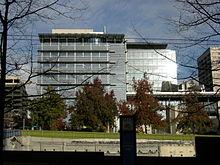
Seattle's political culture is strongly liberal and progressive, although there is a small libertarian movement within the metropolitan area.[216] It is one of the most liberal cities in the United States, with approximately 80% voting for the Democratic Party; only two precincts in Seattle aeone in the Broadmoor community, and one encompassing neighboring Madison Park aehad a majority of votes for Republican George W. Bush in the 2004 presidential election. In addition, all precincts in Seattle voted for Democratic Party candidate Barack Obama in the 2008 presidential election, including the two precincts which had previously voted Republican in 2004.[216] In partisan elections for the Washington State Legislature and United States Congress, nearly all elections are won by Democrats.
Seattle is one of the most politically progressive cities in North America, with a majority of voters supporting Democratic politicians; support for liberal issues such as same-sex marriage, reproductive rights, and gun control is largely taken for granted in local politics. Like much of the Pacific Northwest (which has the lowest rate of church attendance in the United States and consistently reports the highest percentage of atheism[217][218]), church attendance, religious belief, and political influence of religious leaders are much lower than in other parts of America.[219] Seattle also has a thriving alternative press, with the Web-based daily Seattle Post-Intelligencer, several other online dailies (including Publicola and Crosscut), The Stranger (an alternative, left-leaning weekly), and a number of issue-focused publications, including the nation's two largest online environmental magazines, Worldchanging and Grist.org. In July 2012 Seattle became the largest city in Washington State to ban plastic shopping bags.[220]
Federally, Seattle is part of Washington's 7th congressional district, represented by Democrat Jim McDermott, elected in 1988 and one of Congress's most liberal members.[221]
Of the city's population over the age of 25, 53.8% (vs. a national average of 27.4%) hold a bachelor's degree or higher, and 91.9% (vs. 84.5% nationally) have a high school diploma or equivalent.[222] A United States Census Bureau survey showed that Seattle had the highest percentage of college and university graduates of any major U.S. city.[223] The city was listed as the most literate of the country's sixty-nine largest cities in 2005 and 2006, the second most literate in 2007, after Minneapolis, and the most literate in 2008 in a tie with Minneapolis in studies conducted by Central Connecticut State University.[224]
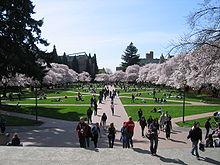
Seattle Public Schools desegregated without a court order[225] but continue to struggle to achieve racial balance in a somewhat ethnically divided city (the south part of town having more ethnic minorities than the north).[226] In 2007, Seattle's racial tie-breaking system was struck down by the United States Supreme Court, but the ruling left the door open for desegregation formulae based on other indicators (e.g., income or socioeconomic class).[227]
The public school system is supplemented by a moderate number of private schools: five of the private high schools are Catholic, one is Lutheran, and six are secular.[228]
Seattle is home to the University of Washington, as well as its professional and continuing education unit, University of Washington Educational Outreach. A study by Newsweek International in 2006 cited UW as the twenty-second best university in the world.[229] Seattle also has a number of smaller private universities including Seattle University and Seattle Pacific University, both founded by religious groups; universities aimed at the working adult, like City University and Antioch University; colleges, such as North Seattle Community College, Seattle Central Community College, and South Seattle Community College; and a number of arts colleges, such as Cornish College of the Arts, Pratt Fine Arts Center, and The Art Institute of Seattle. In 2001, Time magazine selected Seattle Central Community College as community college of the year, stating the school "pushes diverse students to work together in small teams".[230]
The University of Washington is consistently ranked among the country's top leading institutions in medical research, earning special merits for programs in neurology and neurosurgery. Seattle has seen local developments of modern paramedic services with the establishment of Medic One in 1970.[231] In 1974, a 60 Minutes story on the success of the then four-year-old Medic One paramedic system called Seattle "the best place in the world to have a heart attack".[232]
Three of Seattle's largest medical centers are located on First Hill. Harborview Medical Center, the public county hospital, is the only Level I trauma hospital serving Washington, Alaska, Montana, and Idaho.[233] Virginia Mason Medical Center and Swedish Medical Center's two largest campuses are also located in this part of Seattle, including the Virginia Mason Hospital. This concentration of hospitals resulted in the neighborhood's nickname "Pill Hill".[234]
Located in the Laurelhurst neighborhood, Seattle Children's, formerly Children's Hospital and Regional Medical Center, is the pediatric referral center for Washington, Alaska, Montana, and Idaho. The Fred Hutchinson Cancer Research Center has a campus in the Eastlake neighborhood and also shares facilities with the Seattle Cancer Care Alliance and University of Washington Medical Center. The University District is home to the University of Washington Medical Center which, along with Harborview, is operated by the University of Washington. Seattle is also served by a Veterans Affairs hospital on Beacon Hill, a third campus of Swedish in Ballard, and Northwest Hospital and Medical Center near Northgate Mall.
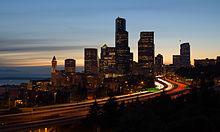
The first streetcars appeared in 1889 and were instrumental in the creation of a relatively well-defined downtown and strong neighborhoods at the end of their lines. The advent of the automobile sounded the death knell for rail in Seattle. Tacoma aeSeattle railway service ended in 1929 and the Everett aeSeattle service came to an end in 1939, replaced by inexpensive automobiles running on the recently developed highway system. Rails on city streets were paved over or removed, and the opening of the Seattle trolleybus system brought the end of streetcars in Seattle in 1941. This left an extensive network of privately owned buses (later public) as the only mass transit within the city and throughout the region.[235]
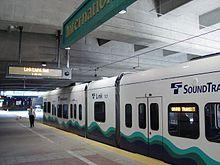
King County Metro provides frequent stop bus service within the city and surrounding county, as well as a South Lake Union Streetcar line between the South Lake Union neighborhood and Westlake Center in downtown.[236] Seattle is one of the few cities in North America whose bus fleet includes electric trolleybuses. Sound Transit currently provides an express bus service within the metropolitan area; two Sounder commuter rail lines between the suburbs and downtown; and its Central Link light rail line, which opened in 2009, between downtown and Sea-Tac Airport gives the city its first rapid transit line that has intermediate stops within the city limits. Washington State Ferries, which manages the largest network of ferries in the United States and third largest in the world, connects Seattle to Bainbridge and Vashon Islands in Puget Sound and to Bremerton and Southworth on the Kitsap Peninsula.[237]
According to the 2007 American Community Survey, 18.6% of Seattle residents used one of the three public transit systems that serve the city, giving it the highest transit ridership of all major cities without heavy or light rail prior to the completion of Sound Transit's Central Link line.[238][239] The city has also been described by Bert Sperling as the fourth most walkable U.S. city and by Walk Score as the sixth most walkable of the fifty largest U.S. cities.[240][241]
Seattle aeTacoma International Airport, locally known as Sea-Tac Airport and located just south in the neighboring city of SeaTac, is operated by the Port of Seattle and provides commercial air service to destinations throughout the world. Closer to downtown, Boeing Field is used for general aviation, cargo flights, and testing/delivery of Boeing airliners.
The main mode of transportation, however, relies on Seattle's streets, which are laid out in a cardinal directions grid pattern, except in the central business district where early city leaders Arthur Denny and Carson Boren insisted on orienting their plats relative to the shoreline rather than to true North.[242] Only two roads, Interstate 5 and State Route 99 (both limited-access highways), run uninterrupted through the city from north to south. State Route 99 runs through downtown Seattle on the Alaskan Way Viaduct, which was built in 1953. However, due to damage sustained during the 2001 Nisqually earthquake the viaduct will be replaced by a tunnel in 2015 at a cost of US$4.25 billion. Seattle has the 3rd worst traffic congestion of all American cities, and is 4th among all North American cities. Additionally, Seattle had the highest increase of traffic among all North American cities between early 2011 and 2012.[243]
The city has started moving away from the automobile and towards mass transit. From 2004 to 2009, the annual number of unlinked public transportation trips increased by approximately 21%.[244] In 2006, voters in King County passed proposition 2 (Transit Now) which increased bus service hours on high ridership routes and paid for five Bus Rapid Transit lines called RapidRide.[245] After rejecting a roads and transit measure in 2007, Seattle-area voters passed a transit only measure in 2008 to increase ST Express bus service, extend the Link Light Rail system, and expand and improve Sounder commuter rail service.[246] A light rail line from downtown heading south to Sea-Tac Airport began service on December 19, 2009, giving the city its first rapid transit line with intermediate stations within the city limits. An extension north to the University of Washington is under construction as of 2010; and further extensions are planned to reach Lynnwood to the north, Des Moines to the south, and Bellevue and Redmond to the east by 2023.[247][248] Mayor Michael McGinn has supported building light rail from downtown to Ballard and West Seattle.[249][250]
Water and electric power are municipal services, provided by Seattle Public Utilities and Seattle City Light respectively. Other utility companies serving Seattle include Puget Sound Energy (natural gas, electricity); Seattle Steam Company (steam); Waste Management, Inc and CleanScapes, Inc. (curbside recycling and solid waste removal); and Verizon Communications, Century Link, and Comcast (telephone, Internet, and cable television).


Word Count: 10558







